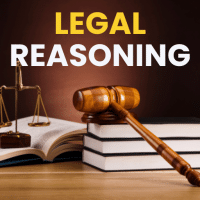CLAT Exam > CLAT Questions > Directions: In the following questions tests...
Start Learning for Free
Directions: In the following questions tests your ability to derive conclusions from complex situations. Read each question carefully and answer the questions that follow.
In national surveys taken between 1970 and 1985, the percentage of respondents who reported that they usually attended weekly religious services rose from 28 per cent to 34 per cent. However, statistics compiled during the same period by the nation’s major religious denominations showed a gradual decline in attendance at weekly services.
Each of the following, if true, could help explain the apparent contradiction in the statements above EXCEPT
- a)There was a sharp drop in the number of persons who attended religious services on an occasional basis.
- b)Attendance statistics compiled by the religious denominations are often highly inaccurate.
- c)As older churchgoers died, they were not replaced by an equal number of younger churchgoers.
- d)There was no significant increase in attendance among religious groups outside the major denominations.
- e)Those responding to the surveys were not representative of the population as a whole.
Correct answer is option 'D'. Can you explain this answer?
Most Upvoted Answer
Directions: In the following questions tests your ability to derive c...
This is one of those items that ask you to find alternative causal explanations. Here, you are asked to find the one choice that does not provide an alternative explanation that would help eliminate the paradox.
Every choice but (D) suggests a way of eliminating the paradox. (D), however, if anything, strengthens the paradox by eliminating a possible way of explaining away the paradox.

|
Explore Courses for CLAT exam
|

|
Similar CLAT Doubts
Question Description
Directions: In the following questions tests your ability to derive conclusions from complex situations. Read each question carefully and answer the questions that follow.In national surveys taken between 1970 and 1985, the percentage of respondents who reported that they usually attended weekly religious services rose from 28 per cent to 34 per cent. However, statistics compiled during the same period by the nation’s major religious denominations showed a gradual decline in attendance at weekly services.Each of the following, if true, could help explain the apparent contradiction in the statements above EXCEPTa) There was a sharp drop in the number of persons who attended religious services on an occasional basis.b) Attendance statistics compiled by the religious denominations are often highly inaccurate.c) As older churchgoers died, they were not replaced by an equal number of younger churchgoers.d) There was no significant increase in attendance among religious groups outside the major denominations.e) Those responding to the surveys were not representative of the population as a whole.Correct answer is option 'D'. Can you explain this answer? for CLAT 2025 is part of CLAT preparation. The Question and answers have been prepared according to the CLAT exam syllabus. Information about Directions: In the following questions tests your ability to derive conclusions from complex situations. Read each question carefully and answer the questions that follow.In national surveys taken between 1970 and 1985, the percentage of respondents who reported that they usually attended weekly religious services rose from 28 per cent to 34 per cent. However, statistics compiled during the same period by the nation’s major religious denominations showed a gradual decline in attendance at weekly services.Each of the following, if true, could help explain the apparent contradiction in the statements above EXCEPTa) There was a sharp drop in the number of persons who attended religious services on an occasional basis.b) Attendance statistics compiled by the religious denominations are often highly inaccurate.c) As older churchgoers died, they were not replaced by an equal number of younger churchgoers.d) There was no significant increase in attendance among religious groups outside the major denominations.e) Those responding to the surveys were not representative of the population as a whole.Correct answer is option 'D'. Can you explain this answer? covers all topics & solutions for CLAT 2025 Exam. Find important definitions, questions, meanings, examples, exercises and tests below for Directions: In the following questions tests your ability to derive conclusions from complex situations. Read each question carefully and answer the questions that follow.In national surveys taken between 1970 and 1985, the percentage of respondents who reported that they usually attended weekly religious services rose from 28 per cent to 34 per cent. However, statistics compiled during the same period by the nation’s major religious denominations showed a gradual decline in attendance at weekly services.Each of the following, if true, could help explain the apparent contradiction in the statements above EXCEPTa) There was a sharp drop in the number of persons who attended religious services on an occasional basis.b) Attendance statistics compiled by the religious denominations are often highly inaccurate.c) As older churchgoers died, they were not replaced by an equal number of younger churchgoers.d) There was no significant increase in attendance among religious groups outside the major denominations.e) Those responding to the surveys were not representative of the population as a whole.Correct answer is option 'D'. Can you explain this answer?.
Directions: In the following questions tests your ability to derive conclusions from complex situations. Read each question carefully and answer the questions that follow.In national surveys taken between 1970 and 1985, the percentage of respondents who reported that they usually attended weekly religious services rose from 28 per cent to 34 per cent. However, statistics compiled during the same period by the nation’s major religious denominations showed a gradual decline in attendance at weekly services.Each of the following, if true, could help explain the apparent contradiction in the statements above EXCEPTa) There was a sharp drop in the number of persons who attended religious services on an occasional basis.b) Attendance statistics compiled by the religious denominations are often highly inaccurate.c) As older churchgoers died, they were not replaced by an equal number of younger churchgoers.d) There was no significant increase in attendance among religious groups outside the major denominations.e) Those responding to the surveys were not representative of the population as a whole.Correct answer is option 'D'. Can you explain this answer? for CLAT 2025 is part of CLAT preparation. The Question and answers have been prepared according to the CLAT exam syllabus. Information about Directions: In the following questions tests your ability to derive conclusions from complex situations. Read each question carefully and answer the questions that follow.In national surveys taken between 1970 and 1985, the percentage of respondents who reported that they usually attended weekly religious services rose from 28 per cent to 34 per cent. However, statistics compiled during the same period by the nation’s major religious denominations showed a gradual decline in attendance at weekly services.Each of the following, if true, could help explain the apparent contradiction in the statements above EXCEPTa) There was a sharp drop in the number of persons who attended religious services on an occasional basis.b) Attendance statistics compiled by the religious denominations are often highly inaccurate.c) As older churchgoers died, they were not replaced by an equal number of younger churchgoers.d) There was no significant increase in attendance among religious groups outside the major denominations.e) Those responding to the surveys were not representative of the population as a whole.Correct answer is option 'D'. Can you explain this answer? covers all topics & solutions for CLAT 2025 Exam. Find important definitions, questions, meanings, examples, exercises and tests below for Directions: In the following questions tests your ability to derive conclusions from complex situations. Read each question carefully and answer the questions that follow.In national surveys taken between 1970 and 1985, the percentage of respondents who reported that they usually attended weekly religious services rose from 28 per cent to 34 per cent. However, statistics compiled during the same period by the nation’s major religious denominations showed a gradual decline in attendance at weekly services.Each of the following, if true, could help explain the apparent contradiction in the statements above EXCEPTa) There was a sharp drop in the number of persons who attended religious services on an occasional basis.b) Attendance statistics compiled by the religious denominations are often highly inaccurate.c) As older churchgoers died, they were not replaced by an equal number of younger churchgoers.d) There was no significant increase in attendance among religious groups outside the major denominations.e) Those responding to the surveys were not representative of the population as a whole.Correct answer is option 'D'. Can you explain this answer?.
Solutions for Directions: In the following questions tests your ability to derive conclusions from complex situations. Read each question carefully and answer the questions that follow.In national surveys taken between 1970 and 1985, the percentage of respondents who reported that they usually attended weekly religious services rose from 28 per cent to 34 per cent. However, statistics compiled during the same period by the nation’s major religious denominations showed a gradual decline in attendance at weekly services.Each of the following, if true, could help explain the apparent contradiction in the statements above EXCEPTa) There was a sharp drop in the number of persons who attended religious services on an occasional basis.b) Attendance statistics compiled by the religious denominations are often highly inaccurate.c) As older churchgoers died, they were not replaced by an equal number of younger churchgoers.d) There was no significant increase in attendance among religious groups outside the major denominations.e) Those responding to the surveys were not representative of the population as a whole.Correct answer is option 'D'. Can you explain this answer? in English & in Hindi are available as part of our courses for CLAT.
Download more important topics, notes, lectures and mock test series for CLAT Exam by signing up for free.
Here you can find the meaning of Directions: In the following questions tests your ability to derive conclusions from complex situations. Read each question carefully and answer the questions that follow.In national surveys taken between 1970 and 1985, the percentage of respondents who reported that they usually attended weekly religious services rose from 28 per cent to 34 per cent. However, statistics compiled during the same period by the nation’s major religious denominations showed a gradual decline in attendance at weekly services.Each of the following, if true, could help explain the apparent contradiction in the statements above EXCEPTa) There was a sharp drop in the number of persons who attended religious services on an occasional basis.b) Attendance statistics compiled by the religious denominations are often highly inaccurate.c) As older churchgoers died, they were not replaced by an equal number of younger churchgoers.d) There was no significant increase in attendance among religious groups outside the major denominations.e) Those responding to the surveys were not representative of the population as a whole.Correct answer is option 'D'. Can you explain this answer? defined & explained in the simplest way possible. Besides giving the explanation of
Directions: In the following questions tests your ability to derive conclusions from complex situations. Read each question carefully and answer the questions that follow.In national surveys taken between 1970 and 1985, the percentage of respondents who reported that they usually attended weekly religious services rose from 28 per cent to 34 per cent. However, statistics compiled during the same period by the nation’s major religious denominations showed a gradual decline in attendance at weekly services.Each of the following, if true, could help explain the apparent contradiction in the statements above EXCEPTa) There was a sharp drop in the number of persons who attended religious services on an occasional basis.b) Attendance statistics compiled by the religious denominations are often highly inaccurate.c) As older churchgoers died, they were not replaced by an equal number of younger churchgoers.d) There was no significant increase in attendance among religious groups outside the major denominations.e) Those responding to the surveys were not representative of the population as a whole.Correct answer is option 'D'. Can you explain this answer?, a detailed solution for Directions: In the following questions tests your ability to derive conclusions from complex situations. Read each question carefully and answer the questions that follow.In national surveys taken between 1970 and 1985, the percentage of respondents who reported that they usually attended weekly religious services rose from 28 per cent to 34 per cent. However, statistics compiled during the same period by the nation’s major religious denominations showed a gradual decline in attendance at weekly services.Each of the following, if true, could help explain the apparent contradiction in the statements above EXCEPTa) There was a sharp drop in the number of persons who attended religious services on an occasional basis.b) Attendance statistics compiled by the religious denominations are often highly inaccurate.c) As older churchgoers died, they were not replaced by an equal number of younger churchgoers.d) There was no significant increase in attendance among religious groups outside the major denominations.e) Those responding to the surveys were not representative of the population as a whole.Correct answer is option 'D'. Can you explain this answer? has been provided alongside types of Directions: In the following questions tests your ability to derive conclusions from complex situations. Read each question carefully and answer the questions that follow.In national surveys taken between 1970 and 1985, the percentage of respondents who reported that they usually attended weekly religious services rose from 28 per cent to 34 per cent. However, statistics compiled during the same period by the nation’s major religious denominations showed a gradual decline in attendance at weekly services.Each of the following, if true, could help explain the apparent contradiction in the statements above EXCEPTa) There was a sharp drop in the number of persons who attended religious services on an occasional basis.b) Attendance statistics compiled by the religious denominations are often highly inaccurate.c) As older churchgoers died, they were not replaced by an equal number of younger churchgoers.d) There was no significant increase in attendance among religious groups outside the major denominations.e) Those responding to the surveys were not representative of the population as a whole.Correct answer is option 'D'. Can you explain this answer? theory, EduRev gives you an
ample number of questions to practice Directions: In the following questions tests your ability to derive conclusions from complex situations. Read each question carefully and answer the questions that follow.In national surveys taken between 1970 and 1985, the percentage of respondents who reported that they usually attended weekly religious services rose from 28 per cent to 34 per cent. However, statistics compiled during the same period by the nation’s major religious denominations showed a gradual decline in attendance at weekly services.Each of the following, if true, could help explain the apparent contradiction in the statements above EXCEPTa) There was a sharp drop in the number of persons who attended religious services on an occasional basis.b) Attendance statistics compiled by the religious denominations are often highly inaccurate.c) As older churchgoers died, they were not replaced by an equal number of younger churchgoers.d) There was no significant increase in attendance among religious groups outside the major denominations.e) Those responding to the surveys were not representative of the population as a whole.Correct answer is option 'D'. Can you explain this answer? tests, examples and also practice CLAT tests.

|
Explore Courses for CLAT exam
|

|
Signup to solve all Doubts
Signup to see your scores go up within 7 days! Learn & Practice with 1000+ FREE Notes, Videos & Tests.























